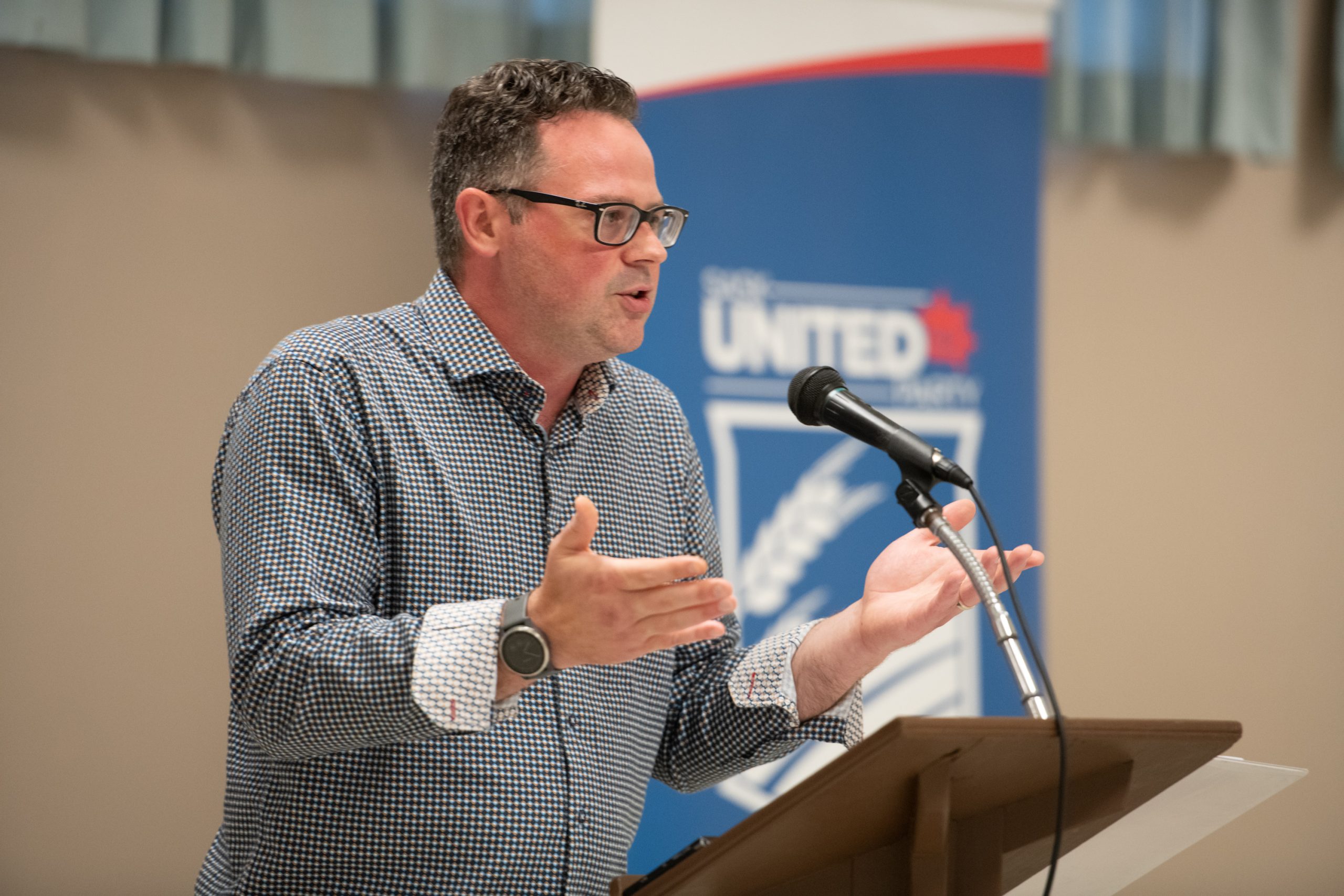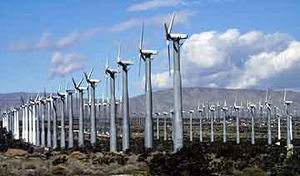Attached photo – Sask United Party Leader Jon Hromek Speaking in Weyburn on July 25, 2024
WEYBURN, SK – It’s not often an oil company CEO sells his company to run for provincial politics, becoming the leader of an upstart party in the process. But that’s exactly what Jon Hromek has done.
With the sale of junior oil producer Adonai Resources II in recent months, Hromek has leapt into politics full-time with the Saskatchewan United Party. He was initially the deputy leader, but founding leader Nadine Wilson, MLA for Saskatchewan Rivers, stepped down, and Hromek has assumed the leadership mantle.
Hromek came to Weyburn on July 25 in one of his first town halls as leader. About 35 people came to hear him speak.
It was an event not unlike the summer of 1997, when four Progressive Conservative and four Liberal MLAs founded the Saskatchewan Party. That winter, the leadership race took place, meeting in church halls just like the one in Weyburn.
The parallels to the formation of the Saskatchewan Party and the Saskatchewan United Party are in some ways striking, as both have their roots in a feeling a conservative voice was not being heard. The difference here is the Sask United feel the Saskatchewan Party has lost its way, whereas the Saskatchewan Party had similar feelings about both the Progressive Conservatives and Liberals.
Hromek personally ran in a byelection in August, 2023, in Lumsden-Morse, motivated in large part by dramatically graphic sexually explicit teaching materials that were being used in the school by Planned Parenthood. That caused a firestorm in and of itself, and Hromek, a political newbie, took 22.7 per cent of the vote despite a late entry into the contest. While the Saskatchewan Party easily carried the seat, it was also a wake up call for the governing party, which soon called the Legislature back into session early that fall to deal with parental rights policy when it came to gender issues.
CEO as politician
As for why an oil CEO, an engineer, is running for politics and is the leader of a party, Hromek said, “While I think we need change, and I was not willing to sit on the sidelines and wait for someone else to get involved. So I decided, you know what, I’m going to throw my hat in the ring. And I’m going to bring the same gusto and the same energy and the same discipline that I put into running an oil company into, into being the leader of this party, and going forward.”
With the largest story in Canada being the whole energy transition, as someone who has worked in energy and is an engineer, does Hromek think that brings a different perspective?
Hromek replied, “One hundred per cent, yeah, absolutely.
“Because I know what I know. And I know what I don’t know. But what I know is that this transition, and this of what’s been pushed for the last 10, 15 years in Canada, it doesn’t make sense, and it’s going to lead to a disaster. And that’s going to hurt every citizen in Canada.
“And so, it’s just about having the conversations and, and putting the steps in place in order to mitigate this and be able to ensure that Saskatchewan can be all it can be. Because at the end of the day, you know what? The people of Saskatchewan deserve this.”
Harnessing resources
In his speech, Hromek said, “With respect to our resources, we must harness our resources to benefit our families and our citizens. We recognize that it is the responsibility of the government to ensure that the wealth of Saskatchewan resources are not exploited by big business, but rather benefits Saskatchewan families and communities. First, we are committed to a vision where the prosperity and well being of Saskatchewan families is first, the wealth generated from our resources should be reinvested into our communities, our families and our future. By promoting responsible resource development, proper and fair royalties and equitable distribution of revenues, we can ensure that the benefits of our natural resource wealth reach every corner of our province.”
CO2 is not a pollutant
Hromek was asked, “When it comes to the federal government who says we’re going to have these Clean Electricity Regulations, which means that by 2035, we can’t produce any power from coal or natural gas, unless we have a very expensive carbon capture which is not as efficient as people think it is. Or we can only run it for 450 hours a year, right until January 19. On any given day, natural gas and coal produces 88 per cent of our power, so what would you do? And that’s why they’re forcing us to build wind and solar. So, what is your policy regarding the federal government forcing Clean Electricity Regulations, and its whole net-zero thing?”
Hromek responded, “Well, I’m a I’m an engineer by trade, a petroleum engineer by trade, and net-zero is something that only exists in an Excel spreadsheet exercise. It violates the first law of thermodynamics.
“The crux of net-zero to the federal government was to create an understanding and a narrative that carbon dioxide is a pollutant. They had to change the definition of carbon dioxide to be a pollutant.
“We know in Saskatchewan, because we’re surrounded by fields as far as you can see that CO2 is not a pollutant. CO2 is the gas of life. It’s plant food.
“Now, so what we would do to address net-zero, because under no circumstance would we ever go along with net-zero. We can’t go along with net-zero. Net-zero will kill agriculture, will kill energy and the resource sector in this province. And basically without carbon dioxide, you die. That’s basically how it works, right?
“So we know, and maybe for a bit of context, the concentration of CO2 in the atmosphere right now is just over 400 parts per million. The concentration of CO2 that is ideal for plant growth is between 1200 and 1400 parts per million. It’s three times higher.
“So, we would challenge the federal government on its definition of CO2, because the crux of all the net-zero regulations, the crux of clean electricity is all on the premise that CO2 is a pollutant. And it’s not.”
He continued, “We already have some case law on this, because remember, when our fantastic federal energy, or environmental activist, I mean, minister, was going after plastic. Remember how he changed the definition of what plastic is? He used the classification to call it toxic. That got pushed all the way to the Supreme Court, and it lost. And the reason is, is because something can’t be toxic, but yet good for you. And you can utilize it every day, all the time that got thrown out.
“So that’s what we would do, because net-zero is not going to happen for Saskatchewan. It can’t. Long-term, it just can’t happen. But we’re going to attack it at the crux, and the crux of it is to attack it on CO2, and that not being classified as a pollutant.
“So that’s the way. Even when the Sask Party had taken the government to court, I believe it was 2017, 2016, somewhere in that when they took it to court, they were arguing over who has jurisdiction over air pollution. That case was doomed to fail. Because if it’s classified as a pollutant, if it’s in the air, it’s going to cross jurisdictional boundaries, provincial boundaries, which automatically makes it federal jurisdiction. We need to fight from our hill. Our hill is the fact that CO2 is not a pollutant, and fight from that hill.”
Raking in CO2 dollars
Hromek took issue with one of the greenhouse gas emissions programs, which the Saskatchewan government is now benefiting from financially. He said, “We do have a provincial program in Saskatchewan that was designed to meet federal equivalency, it’s called the Output Based Performance Standard, OBPS. And, that standard goes across to the larger emitters. Myself and my company were one, for flaring in southeast Saskatchewan, and the government of Saskatchewan collected … just under $500 million dollars from that this this year.
“So, while premier Moe is out fighting over the withholding of natural gas monies, which was about $25 million, … His government has collected $500 million dollars, and that’s sitting in their coffers.
“So, when I say we’re going to cut the gas tax, guess which money we’re going to use? We’re going to use the money that came in through the OBPS program. And we’re going to give it right back to our citizens. Because if you want to go after Trudeau, that’s how you do it.”
We’re going to burn coal until we run out of coal
Asked about windmills and solar panels, he said, “The reason that they were going that way was because they were trying to appease the Feds and expand out the windmills and solar panels.
He noted, “People ask me all the time, ‘Jon, how long do you want to burn coal for?’
“I say, I always say, ‘We’re going to burn coal until we run out of coal.’”
“That’s what we have. That’s what we’ve been given. And that’s what we’re going to do. And it’s efficient. And it’s good.
“But if you take a coal plant and retrofit it to natural gas combined cycle, it, the cost is about $900,000 per megawatt. Solar is about $2.7 million per megawatt. But it only runs in Saskatchewan at 18.8 per cent of the time of its actual capacity that you build. So that works out to about $14 million a megawatt is what you’re spending the money on. Wind, $1.1 million, but the nameplate capacity is about 38 per cent. So that’s equivalent to about $3 million is how much you’re spending per megawatt. To do that. It’s just not efficient, it just doesn’t make sense.
“And the issue with wind and solar is once you have it on a grid, it makes your grid unstable. Electricity flows down a copper line, like water flows down the pipe, meaning it can’t flow in two directions at the same time. So the more renewables or the more intermittent sources of energy you have on your grid, the harder it is, for your grid operator, in this case, SaskPower, to be able to manage that grid without having blackouts or having your power failures in order to offload. Because once electricity is generated, it has to flow.
“That’s actually what was taking place in Alberta, when Alberta went and they had all those blackouts, when it was very dangerous, when it was minus 38 or something like that. The main reason why their grid was having so many issues is because they massively expanded wind and solar onto that grid. And that grid has now become so unstable.
“It’s sad, because Alberta used to have an awesome power grid based on coal and natural gas. And now, I mean, it was just last week, they were having grid alerts again, it’s become so unstable, that it just can’t meet the needs of its citizens. We don’t want to go there. And I’m just talking from an economic perspective, as well as the perspective of providing a service. We don’t want to go there.
“And I’m just talking from an economic perspective, as well as the perspective of providing a service. We don’t want to go there.”
Yes to nuclear power, but questions SMRs
Asked about nuclear power, Hromek said, he was very pro-nuclear, and that Saskatchewan produces the highest grade of uranium in the world. But he said Saskatchewan should be enriching uranium, “because that’s where the real money is.”
He’s not so sure about small modular reactors, saying this type of reactor is still in its early stages, with one in Russia and one in China that are running right now. The American NuScale project has recently been scrapped in pre-feasibility. And the cost per megawatt, so far, is running high, as much as $30 million per megawatt.
“X-energy in the United States, they’re at about $25 million per megawatt. But again, they’re still in the feasibility stage. They’re not even into construction.
“The GE-Hitachi in the US, this is the one that SaskPower is basing its thoughts on, or its engineering on. They’re right now at $17 million per megawatt, but they’re only three years into the project and haven’t done anything yet.
Hromek warned of skyrocketing costs.
“So as these projects are expanding out, and they’re getting further and further into the phase, those costs are just skyrocketing. Because the GE-Hitachi plant, originally in in its scoping, it started at $4 million per megawatt. And it’s already at $17 million after three years.
Brian Zinchuk is editor and owner of Pipeline Online, and occasional contributor to the Frontier Centre for Public Policy. He can be reached at brian.zinchuk@pipelineonline.ca.



